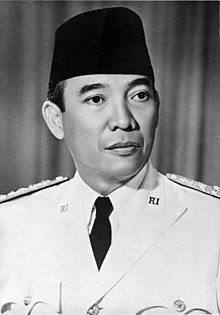Songkok

The Songkok ( Malay ; also called Peci or Kopiah ) is a traditional Indonesian cap in the shape of a truncated cone . It is almost always made of felt , wool or velvet . It is widely used primarily among men in Indonesia and Malaysia , but also in Brunei , Singapore , southern Thailand and the Philippines .
The headgear is not only worn by Muslim men. B. can often see the former Christian governor Jakartas, Basuki Tjahaja Purnama .
Caps similar to the Songkok are worn in Morocco , among others .
The Songkok is worn on special occasions such as a wedding celebration, a funeral or Islamic festivals. The Songkok became everyday clothing with the arrival of Islam in the Malay archipelago in the 13th century.
In some parts of Indonesia the Songkok is referred to as Peci (especially the variant made of black felt) and in Mindanao , Borneo and West Java as Kopiah .
In Indonesia, the peci is also used as a nationalist symbol. Among other things, it was often worn by Presidents Sukarno (1945–1967) and Suharto (1967–1998), as well as - especially during the time of the Orde Baru - generally by politicians and officials, with the level of the peci being the rank of the bearer is shown.
See also
Web links
Individual evidence
- ^ Rozan Yunos: The origin of the songkok or 'kopiah'. ( Memento of the original from December 5, 2008 in the Internet Archive ) Info: The archive link was inserted automatically and has not yet been checked. Please check the original and archive link according to the instructions and then remove this notice. In: The Brunei Times , September 23, 2007.
- ↑ Jan Aart Scholte: The International Construction of Indonesian Nationhood, 1930-1950. In: Imperial Policy and Southeast Asian Nationalism. Routledge, Abingdon (Oxon) 1995, pp. 191-226, at p. 198.
- ^ Willem Westerkamp: Ethnicity or Culture. The Career of Mannequins in (Post) Colonial Displays. In: Sites, Bodies and Stories. Imagining Indonesian History. Pp. 89–112, at p. 105.
- ↑ Margaret Maynard: Dress and Globalization. Manchester University Press, Manchester / New York 2004, p. 62.